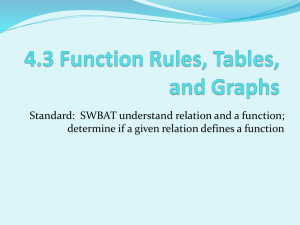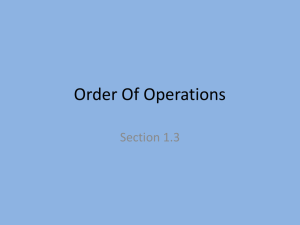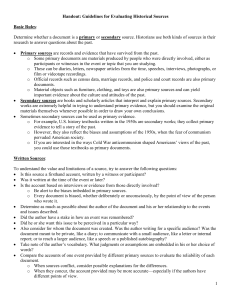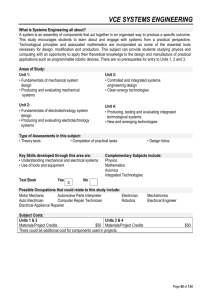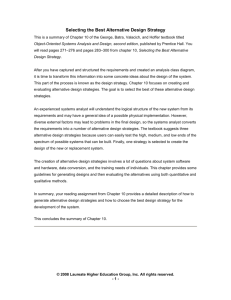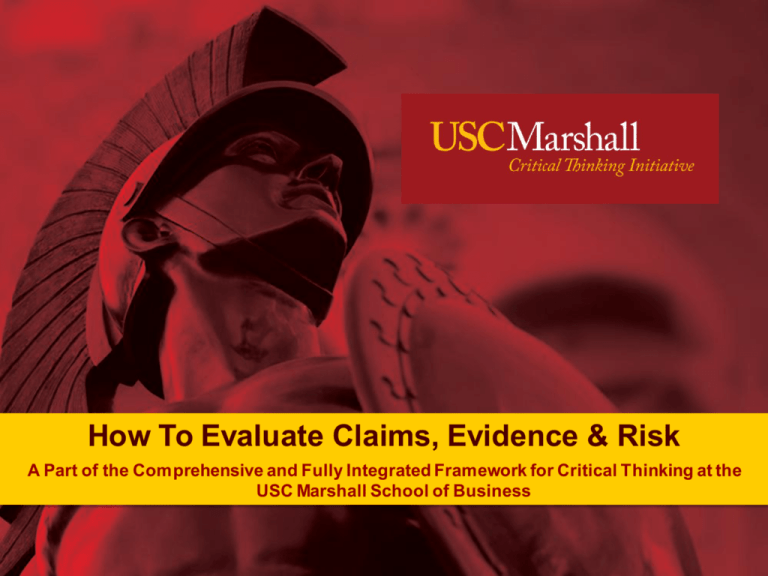
How To Evaluate Claims, Evidence & Risk
A Part of the Comprehensive and Fully Integrated Framework for Critical Thinking at the
USC Marshall School of Business
USC Marshall Critical Thinking Initiative
• The USC Marshall Critical Thinking Initiative is an on-going school wide
effort to enhance our students’ critical thinking skills in order to make them
more successful problem solvers. Its key components include…
The 5 Step USC-CT Problem Solving Process which is designed to help students
tackle ambiguous, ill-defined challenges.
The START Concept Analysis which is designed to teach fundamental
concepts/formulas that are utilized within the USC-CT Process.
Learning Modules which are designed to enhance specific skills such as how to
reduce biases, how to enhance creativity, and how to evaluate claims & evidence.
• The lesson in this document focuses on Evaluating Claims, Evidence,
and Risks
2
Evaluating Claims, Evidence, and Risks
(Note: This document is meant as an introduction to the subject. More in-depth coverage
will occur in supplemental readings and classroom exercises)
3
Evaluating Claims, Evidence, and Risks
• Objective: This module is designed to help students critically and skeptically
evaluate claims and evidence because business decisions depend upon
accurate information well interpreted.
• Approach: The Socratic approach is used to help students delve deeper into the
assumptions and data that underlie beliefs in order to distinguish between valid
and invalid arguments.
4
Evaluating Claims & Evidence
• Arguments, Claims and Evidence
The Argument: An “argument” is a statement that others are trying to convince you is
true in order to persuade you. The argument contains two elements…
The Claim: This is a conclusion that someone is attempting to get you to believe.
The Evidence: This is the information used to support the claim.
Examples:
Our new advertising campaign is ineffective (the claim) because sales fell by 20% when the
new campaign was introduced (the evidence).
Our company’s new sexual harassment seminars are not working (the claim) because reported
sexual harassments are up 50% ever since the seminars began (the evidence).
Our company’s desire to buy its closest competitor is misguided (the claim) because its
price/earnings ratio (P/E) is 50 and well above the average P/E (the evidence).
But are these arguments valid?
5
Evaluating Claims & Evidence
• Key Elements to Consider:
Look for alternate explanations for the claim
Realize that correlation is not the same as causation
Avoid being misled by “hard facts”
Consider the credibility of the source of the claim
Don’t be misled by the presenter’s spin & exaggerations
Don’t be misled by your own biases
6
Evaluating Claims & Evidence
Look For Alternate Explanations for the Claim. Examples…
Our new advertising campaign is ineffective (the claim) because sales fell by 20% when
the new campaign was introduced (the evidence).
Perhaps sales declined because competition introduced a new product at the same
time, or the economy went into recession, or the product became counter-trend.
Our company’s new sexual harassment seminars are not working (the claim) because
reported sexual harassments are up 50% ever since the seminars began (the evidence).
Perhaps reported harassment went up because the seminars gave employees the
courage to finally register complaints that had previously gone unreported due to fear.
Conclusion: Consider all possible explanations, and do research to ascertain
which is the most likely root cause.
7
Evaluating Claims & Evidence
Realize that Correlation Is Not the Same As Causation. Examples…
Just because sexual harassment claims went up after the seminar does not
mean that the seminar caused sexual harassment.
Just because a great many people die in hospitals (deaths correlate high with
hospital stays) does not mean that hospitals cause deaths.
Conclusion: Don’t assume high correlation = causation. Look for 3 rd party
causes.
8
Evaluating Claims & Evidence
Avoid Being Misled by “Hard Facts”. Examples…
Averages:
The average salary for the Acme Company’s 100 employees is $75,000! But deeper
inspection reveals that 99 of them make $10,000 and the CEO makes $6.51 million.
The “average” consumer of your product is age 45. But deeper inspection reveals
that none are age 45. They divide into two segments; ages 25-35 and age 55-65.
Bases:
“Sales are up by 75%!” But deeper inspection reveals that the base was only
$10,000 to begin, giving a total of $17,500, far short of a $50,000 goal.
“It’s the #1 brand” could mean it has the highest market share, but it’s not much if the
share is only 7%.
Conclusion: Dig deeper into numbers. Find the missing/hidden data.
9
Evaluating Claims & Evidence
Avoid Being Misled by “Hard Facts”. Examples…
Indices:
A consumer segment indexes high for your product (index=500) suggesting it should
be a prime target. But deeper inspection reveals that the segment represents only
1% of population that consumed 5% of product. High index, but too small overall.
Samples:
The average starting salary for graduating MBAs at a particular school is $100K. But
the sample may be among only those who responded to the survey (who likely had
jobs), and those who responded may not be truthful.
Projecting that a candidate is likely to win the presidency does not mean much if it is
based on a small sample or a non random one.
A projected sales of $100 million can vary greatly if the probability of it being accurate
at the 90% confidence level is +/- 20%.
Conclusion: Dig deeper into numbers. Find the missing/hidden data.
10
Evaluating Claims & Evidence
Consider the credibility of the Source of the Claim. Examples…
Is the source really an expert?
Is the source unbiased?
Is the sample small/invalid?
Conclusion: If the source is not an expert, or has a vested interest, or is
based on an invalid sample, look for a neutral 3 rd party analysis.
11
Evaluating Claims & Evidence
Don’t Be Misled By the Presenter’s Spin and Exaggerations
Spin/Framing: “A whopping 40% of consumers agree” vs. “Only 40% of consumers
agree”. A “used car” vs. a “pre-owned car”
Exaggerating:
“He’s always wrong”
“Sales are through the roof”
“As everyone knows”
Conclusion: Ignore the spin and exaggerations. Draw your own conclusions.
12
Evaluating Claims & Evidence
Don’t Be Misled By Your Own Biases. Examples…
Confirmation Bias: Accepting, ignoring, and /or rejecting information because it supports
or doesn’t support a preexisting opinion.
Self-Serving Bias: Selecting info/solutions to further personal goals, not organizational
ones.
Availability Bias: Relying upon knowledge that is readily available rather than examining
other alternatives or procedures.
Plus many more that are in a separate critical thinking module.
Conclusion: Need to first recognize and then eliminate your own biases.
13
Evaluating Claims & Evidence
U
S
C
C
T
Uncover the various
potential problems,
challenges &
opportunities vis-à-vis
organizational goals.
Select the most
critical problem(s),
challenge(s) and/or
opportunity(ies).
Prioritize.
Create a multitude
of potential
solutions.
Choose the
solution(s) that
has the potential
to be the most
effective.
Translate your
solution(s) into
an effective
implementation
plan.
Evaluating Claims & Evidence
If you are using the 5 Step USC-CT Problem Solving Process, evaluating claims and
evidence is particularly important when selecting the most critical problem, challenge
and opportunity, and when choosing the solution that has the most potential of being
effective.
14
Evaluating Risks
U
S
C
C
T
Uncover the various
potential problems,
challenges &
opportunities vis-à-vis
organizational goals.
Select the most
critical problem(s),
challenge(s) and/or
opportunity(ies).
Prioritize.
Create a multitude
of potential
solutions.
Choose the
solution(s) that
has the potential
to be the most
effective.
Translate your
solution(s) into
an effective
implementation
plan.
Evaluating Risks
Identifying/evaluating risks of each recommendation is critical when implementing solutions
This gives you the downside of each potential solution.
You may rethink your decision because of the potential impact on the bottom line.
It might bring out other areas to consider before taking actions.
15
Evaluating Risks
U
S
C
C
T
Uncover the various
potential problems,
challenges &
opportunities vis-à-vis
organizational goals.
Select the most
critical problem(s),
challenge(s) and/or
opportunity(ies).
Prioritize.
Create a multitude
of potential
solutions.
Choose the
solution(s) that
has the potential
to be the most
effective.
Translate your
solution(s) into
an effective
implementation
plan.
Evaluating Risks
Positioning lightly carbonated fruit flavored water as a water beverage vs. a carbonated
beverage could be perceived incorrectly without market acceptance thus causing new
product failure and damage to the brand.
Using the brand name of a product in a new category could cause confusion and lack
of association with the new category resulting in a new product failure.
Distributing a new product in inappropriate retail stores or in areas of stores that are
not where the items are typically found will result in missed sales goals and losses.
16
Conclusion
In order to make sound decisions and recommendations to address any
business challenge, issue, and/or problem:
Evaluate all of the facts, including claims or evidence.
Always question any claims made with additional questions to ensure evidence is
accurate and unbiased.
Evaluate each priority issue/challenge/problem before making final recommendations
with a risk assessment. Assess the magnitude of the risk associated with each
recommendation.
Make your recommendations to address the top priority problems with more
confidence and a higher degree of success by following the rigor of the USCCT Framework!
17
USC Marshall Critical Thinking Initiative
Recap
18
USC Marshall Critical Thinking Initiative
• The USC Marshall Critical Thinking Initiative is an on-going school wide
effort to enhance our students’ critical thinking skills in order to make them
more successful problem solvers. Its key components include…
The 5 Step USC-CT Problem Solving Process which is designed to help students
tackle ambiguous, ill-defined challenges.
The START Concept Analysis which is designed to teach fundamental
concepts/formulas that are utilized within the USC-CT Process.
Learning Modules which are designed to enhance specific skills such as how to
reduce biases, how to enhance creativity, and how to evaluate claims & evidence.
Check them all out!
19

